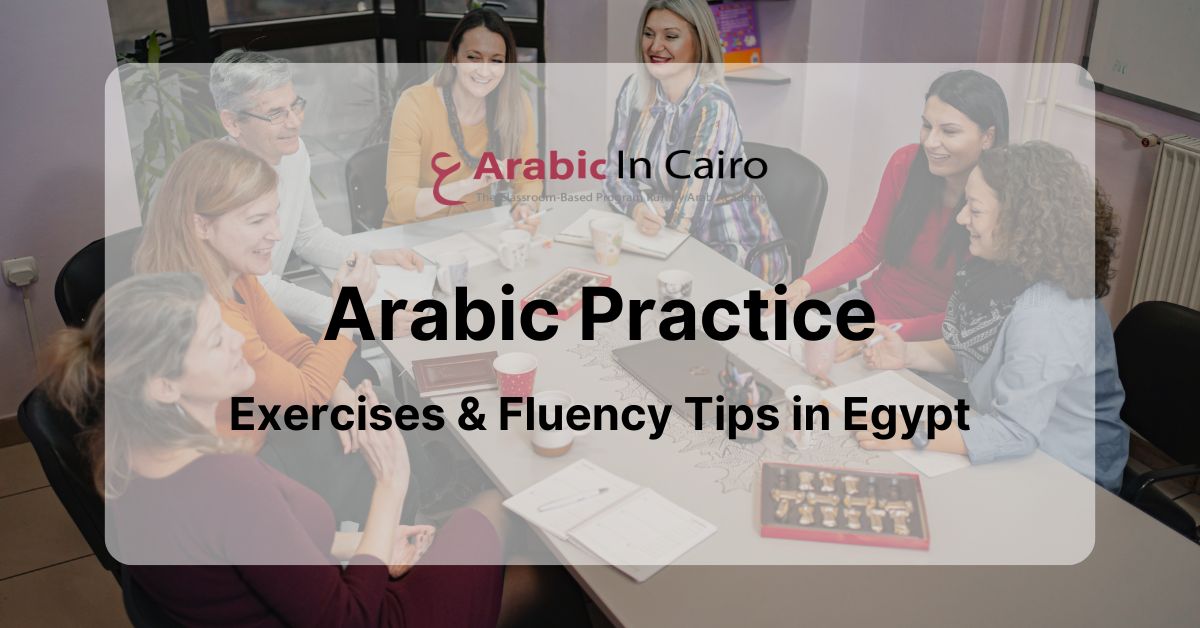How to Learn Egyptian Arabic: The First Steps to Speak Like a Local
If you’re planning to learn Egyptian Arabic, do it the Cairo way on the street, in the café, on the Metro, and in a classroom that turns daily life into practice. This guide shares exactly how learners of Arabic in Cairo get from “salām” to full conversations, with practical routines, real student stories, and local tips you can start using today.
What makes Egyptian Arabic unique?
Spoken by over 100 million people, Egyptian Arabic is the voice of Egyptian cinema, music, and comedy, making it the most widely understood dialect across the Arab world. But learning it isn’t just about grammar or vocabulary; it’s about rhythm, humour, and daily expressions that locals use every day. Choosing Cairo as your base means you’re surrounded by this living language 24/7, from the driver who jokes with you in traffic to the shopkeeper who teaches you a new phrase while giving back your change.
Your first month: building habits, not just vocabulary
How to learn Egyptian Arabic (week 1)
Start by training your ear. Focus on the sounds that mark Egyptian speech and learn “survival sentences” that get you through daily routines, ordering food, asking directions, and paying at the market. Each interaction becomes a practice ground, turning theory into memory.
Learn to speak Egyptian Arabic (weeks 2–3)
Shift from memorising words to using them in real tasks. At Arabic in Cairo, learners practice situations they’ll actually face: asking a pharmacist for medicine, chatting with a barista about football, or confirming a ride. Every role-play in class gets tested on the street right after.
Hearn Egyptian language through city life (week 4)
Instead of waiting months to “feel ready,” you step out early. Guided city outings take you to places like Khan El-Khalili or a neighbourhood bakery, where you practice buying, bargaining, and greeting. By the end of your first month, you’ll notice locals answering back naturally, and you’ll realise you’re truly part of the conversation.
Case studies: proof from our classrooms
From textbook to street talk
One student reported that two focused months in our small-group program gave more speaking confidence than a full academic year elsewhere. Daily tasks, outings, and constant feedback made the difference.
A professional’s fast start
A mid-career diplomat joined, needing both office and street Arabic. Alternating Modern Standard for briefs with Egyptian Arabic for meetings, she was able to navigate receptions, taxis, and negotiations without defaulting to English.
Make Cairo your classroom
Learn Egyptian (sound & rhythm)
Shadow short clips from Egyptian TV or songs, 30–60 seconds on loop. Mimic melody and stress, not just words. Record yourself weekly to track progress.
Learn to speak Egyptian (word power that matters)
Aim for the most frequent 1,000–2,000 everyday word phrases you’ll actually use at the kiosk, café, or in a taxi. Build mini-lists by theme (food, directions, money) and recycle them in conversations the same day.
Routine that sticks
Consistency beats intensity: 20 hours/week in class, 15 minutes/day of shadowing, three real-world micro-missions after class, and a weekly teacher check-in.
How we teach Arabic in Cairo (and why it works)
Small groups, big speaking time
With a six-student cap, you’ll speak every hour, not just listen. Teachers rotate, so you hear different voices and get multiple feedback styles.
Monthly starts, flexible tracks
Join full-time (4 hours/day, 5 days/week) for maximum immersion, or pick part-time when work is busy. New classes start monthly, so you can align learning with your schedule.
Outings turn knowledge into confidence
Some sessions take you outside ordering, asking, and bargaining with your instructor there to coach. The next day, you reinforce the same language in class to solidify it.
Garden City convenience
The centre is in a quiet neighbourhood near downtown Cairo. Most learners walk to class, grab koshari nearby, and use the Metro or ride-hailing to explore. You’re learning in the same places you’ll live.
Resource stack: Cairo-tested tools
Listening
Short clips from Egyptian shows, voice notes with classmates, and teacher-curated dialogues. Keep clips under a minute and loop them until you predict the next line.
Speaking
Daily “speaking sprints”: 5-minute monologues about your day, recorded and reviewed with your teacher. It exposes pronunciation gaps quickly.
Vocabulary
Build bite-size lists tied to your life: groceries, transport, work. Write phrases, not single words and use them the same day.
Ready to turn Cairo into your classroom? Join the next monthly intake and build real-world fluency with small groups, expert coaches, and city-day practice. Apply now or contact us for a placement test and start date.
FAQs
Is Egyptian Arabic different from Modern Standard Arabic?
Yes. Modern Standard Arabic (used in news and formal writing) differs from Egyptian Arabic (used in daily speech). Most learners start with Egyptian for conversations, then add MSA later.
How long before I can hold a basic conversation?
With 20 hours/week in class plus daily practice, many learners can manage transport, food, and small talk within the first month. Consistency matters most.
Can I start online and continue in Cairo?
Absolutely. Many learners begin online to build fundamentals, then come to Cairo for immersion. Your placement carries over.
Is Cairo safe for students?
Our centre is in Garden City, an embassy district with good security and easy access to metro and taxis. Daily life is welcoming and manageable.
Do you offer part-time options?
Yes, choose part-time tracks when your schedule is tight, then switch to full-time when ready. New cohorts start monthly.







